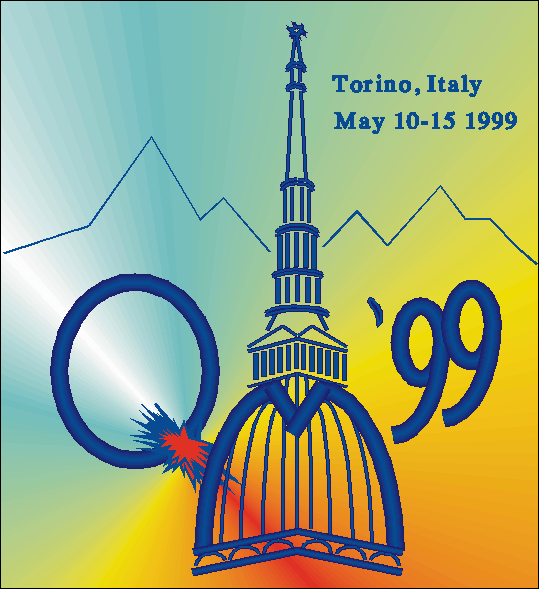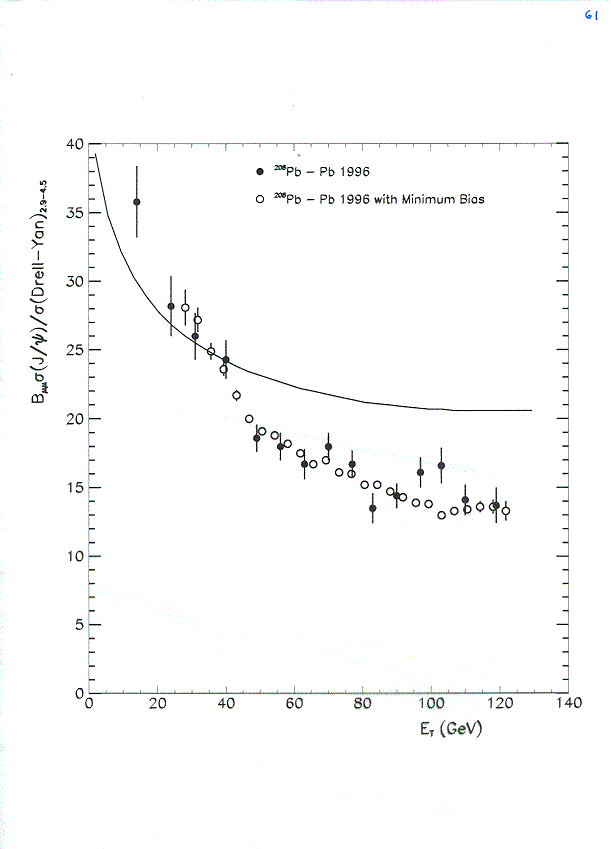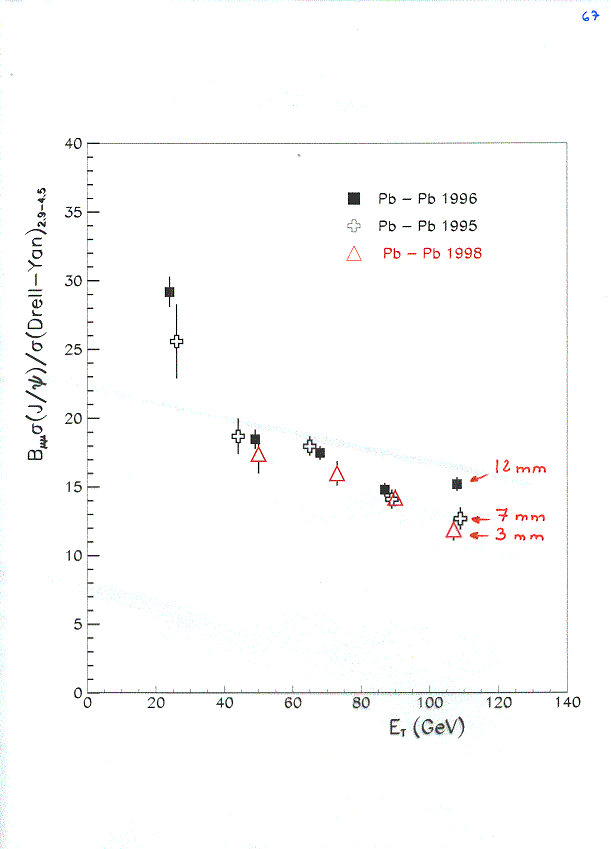Ambivalent signals
14th International Conference on
Ultra-Relativistic Nucleus-Nucleus Collisions
Torino, 10. - 15. May, 1999
The 14th Quark Matter Conference took place in Torino, Italy (Fig.1).
About 500 physicists from many countries discussed new theoretical
and experimental implications of nucleus-nucleus collisions
at ultra-relativistic energies. The focus was on fixed-target experiments,
but also the upcoming physics with colliding beams was
debated: The Relativistic Heavy-Ion Collider (RHIC) in Brookhaven will
start operating already this year, and experiments at the Large
Hadron Collider (LHC) in Geneva will begin in the middle of the next decade
at even higher energies. With this last conference before the
start of the collider experiments, the field has reached a plateau.
In about 30 invited lectures, 100 presentations in up to three
parallel sessions and about as many posters the conference took
the opportunity to review the present achievements of the field,
and to take a look into its future.
The main aim is still the search for signals of quark-gluon plasma (QGP)
formation. Lattice gauge theory predicts on the basis of quantum
chromodynamics (QCD)
that hadronic matter undergoes a phase transition to this new phase when
the energy density is increased by about one order of magnitude above the normal
value. These very elaborate first-principle numerical calculations still have
unsolved technical problems at finite baryon densities. However, there is
general confidence that the quark-gluon plasma not only existed in thermodynamic
equilibrium at the beginning of the evolution of the universe, and still
exists in
the interior of neutron stars, but can also artificially be created for a
very short time
interval in the nonequilibrium collision of heavy nuclei at relativistic
energies. The hope that
it can be detected is the main cornerstone of the field. An unambiguous
detection
of the QGP would be of basic importance for the progress of knowledge in
science. In
the past 20 years, the methods to provide evidence for QGP- formation have
constantly been improved, and the results were discussed on the
Quark-Matter conferences.
Essential conditions for plasma formation are indeed fulfilled in present
experiments with heavy projectiles and fixed targets. In the - now
terminated - experiments at the Alternating Gradient Synchrotron (AGS) in
Brookhaven with a gold beam of 11 GeV per nucleon incident energy one has
almost reached the critical value of the energy density of about 1.5
GeV/fm^3. At the SPS in Geneva, central Pb + Pb - reactions at 156 GeV per
nucleon incident energy produce an energy density of about 3 GeV/fm^3,
which is safely
above the critical value. Various observations indicate that in the dense
hot zone - the
"fireball" - created in central collisions of heavy nuclei at relativistic
energies, quarks may be deconfined from hadrons into the quark-gluon
plasma, and that the so-called chiral symmetry
of QCD is restored. When leaving the reaction zone, quarks and gluons
hadronize: they
form strongly interacting hadrons, which are then - together with the
weakly interacting leptons that are created during the collision - detected
with their momentum distributions and cross sections.
Even though AGS- and SPS- experiments have meanwhile delivered the precise
data they were built for, it remains extremely difficult to draw
conclusions regarding a possible deconfinement from the large variety of
hadronic and leptonic observables. Most promising are presently three
groups of signals, which were discussed in Torino by the AGS- and SPS-
collaborations as well as by theorists in all details:
€ - Strangeness-enhancement: As compared to the values extrapolated from
proton-nucleus reactions, relativistic nucleus-nucleus reactions produce a
significantly enhanced yield of strange particles. At SPS-energies, this
could be due to intermediate plasma formation. For
example, the production of the Omega-hyperon exceeds the expectation from p-A
collsions by about a factor of 15.
€
- Dilepton-anomaly: The dilepton-spectra at small invariant masses measured by the Ceres
(NA 45)- collaboration are anomalously enhanced. This could be interpreted
as a consequence
of the decrease of the mass of the rho-meson in the medium, and/or an
increase of its spectral width. The connection of this effect with the
possible restoration of chiral symmetry in the
QGP is not yet completely clear. Ceres data from the 1996 run are
systematically lower than, but consistent with the results from 95. To
increase statistical significance, the apparatus is
being upgraded.
€
- J/Psi suppression: After the initial theoretical prediction of a smaller
J/Psi- production rate
in nucleus-nucleus collisions (as compared to p-p-collisions) as a possible
signal for
deconfinement by T. Matsui and H. Satz in 1986, one had found a
corresponding effect in experiments with oxygen and sulfur projectiles.
However, a suppression is also found in
proton-nucleus reactions, as emphasized again in Torino by the E866/NuSea
collaboration
(Fermilab) and hence, a hadronic origin of the effect - absorption of the
J/Psi in the nuclear
medium - appears plausible. Indeed the NA50 data for medium-heavy systems
(normalized to
the Drell-Yan cross section for direct lepton-pair production via a virtual
photon) are in good
agreement with a hadronic scenario, whereas in central Pb-Pb-collisions
significant deviations
by 8 - 10 sigma from the value consistently expected by many available models
and extrapolations for hadronic absorption are found. The anomalous
suppression increases with rising transverse energy (decreasing impact
parameter) to the central value; it could be a signal for plasma formation.
However, there are also purely hadronic scenarios which agree with the data
and hence, offer no indication for anomalous suppression, or plasma formation.
The NA50 results were presented by C. Cicaḷ and - in a summary talk - by
Louis Kluberg, Fig. 2. They complemented the results already shown at the
Quark Matter Conference 1996 in Heidelberg. The suppression depends
sligthly on the target thickness
(7mm, 12 mm, 3 mm). Results of the 1998 run with a thin target are most
reliable, because
distortions due to multiple scattering are minimized. About 40 000 J/Psi
events were analyzed.
In spite of such hints at deconfinement, all the possible signals found so
far are necessary,
but not yet sufficient conditions for quark-gluon plasma formation in
relativistic nucleus-nucleus-collisions. The signals were discussed in
great detail in the various experimental and theoretical sessions. For
example, the strangeness-enhancement that had been predicted theoretically
in 1982 can be investigated in terms of the K^+/p^+ - ratio. Whereas the
K^-/p^- - ratio is approximately equal to the result from proton-proton-
collisions, a considerable enhancement for the positively charged particles
had been found already in 1987 at the AGS (Si+Au) and the SPS (S+S) due to
the high baryon density, which was later carefully investigated and
discussed again in Torino. Comparing to transport calculations there
are difficulties to interpret AGS- and SPS- data simultaneously in a
consistent fashion. The AGS-results appear to support a hadronic scenario,
which is not the case for the SPS data.
Strangeness-enhancement increases with the strangeness-content of the
produced particles and hence, is most prominent for Xi-hyperons (two strange
quarks) and Omega-hyperons (three strange quarks). It is often assumed that
strangeness- production freezes out in the early stages of the reaction
when the energy density is at its maximum value (J. Rafelski). Hence,
chemical equilibrium would not be achieved, the available time is not
sufficient for equilibration.
This is in contrast to other studies of hadron production rates which have
been used to gain information about the system at freeze-out. They show
that the relative abundancies of produced hadrons at AGS- and SPS-energies
are essentially determined by the freeze-out temperature and the
baryo-chemical potential, as is expected for thermal and chemical
equilibrium. As already stated by Rolf Hagedorn in 1965, the available phase
space dominates the hadron production. It obeys the principle of maximum
entropy at freeze-out. The agreement of this picture with the data is good,
J. Stachel even showed an extrapolation to RHIC energies. The chemical
freeze-out parameters at SIS-, AGS- and SPS- energies correspond to a
single value of 1 GeV for the mean energy per hadron (K. Redlich et al.).
Transverse momentum distributions and other data may be interpreted with
the assumption of thermal equilibrium and collective expansion. Numerous
flow-analyses and hydrodynamic calculations were also performed and
presented.
However, the good agreement of the phase-space model with many data is not
a sufficient condition for the attainment of thermal and baryo-chemical
equilibrium in the system. Due to the short interaction times of about
10^-23 s even in central collisions, equilibrium is generally not achieved.
Transport calculations of the BUU-type, event generators and also
analytical models (such as a relativistic diffusion model) show in
comparison with data that heavy systems at AGS- and, in particular,
SPS-energies do not equilibrate dynamically. As a consequence, the scenario
of a phase transition into an equilibrated quark-gluon phase, as well as
the direct applicability of latttice gauge calculations to nucleus-nucleus
collisions appears questionable. This view is supported by the fact that so
far no indications for critical phenomena expected in the presence of a
phase transition have been found. An example is the analysis of
event-by-event fluctuations that becomes possible due to the high
multiplicities at SPS- energies, as performed by the NA49 collaboration.
Here, the fluctuations of the transverse momentum of produced pions and
other observables behave statistically and give no hints at any critical
behaviour that may be indicative of a phase transition.
The SPS-physics is by no means completed, and will continue to generate
interesting and relevant results, for example, with the forthcoming
experiments at lower beam energy of
40 (and probably 80) GeV per nucleon, which will produce better stopping
and higher baryon density. Nevertheless, in Torino much attention was
caught by the upcoming collider-physics with heavy ions. The detector
systems PHENIX, PHOBOS and STAR at RHIC, and ALICE
(and CMS) at LHC were introduced, and a whole day was reserved for
theoretical predictions of the various models and event-generators at RHIC
energies. Significant differences in the predictions for important
observables such as rapidity distributions for protons or negative hadrons
could be noticed, such that the measurements will surely not be replaced by
event-generation in the computer. Even stronger J/Psi- suppression will be
expected at RHIC.
M. Gyulassy gave a summary of RHIC- predictions and showed a rosette of the
most important observables, with the possibility to detect the quark-gluon
plasma in the center. P. Braun-Munzinger presented a visionary talk about
the future physics at LHC, where center-of-mass energies of 1150 TeV -
corresponding to a macroscopically relevant energy of 0.18 mJ - are
produced, energy densities of 1 TeV/ fm^3 are expected and 17 units of
rapidity are covered. His remark that at collider energies J/Psi- mesons are
also produced indirectly from B-decays which must be detected separately is
likely to become relevant for RHIC, too.
In addition, Upsilon-mesons (bottom-antibottom systems) should become a sensible
signal for plasma
formation in the region of low baryon content at collider energies.
In summary, even though there are signs for deconfinement, there is still a
long way to go until
the possible transient existence of a quark-gluon plasma in relativistic
heavy-ion collisions may be proven without doubt. The aim of the field
remains relevant, and attracts many young scientists. It will continue to
expand on the basis of the future collider experiments in Brookhaven -
where the next conference of this series will take place - and Geneva.
G. Wolschin
Figures
 Fig.1: The 14th Quark-Matter Conference in May 1999
took place in Torino. The conference logo includes the
symbol of the city, Mole Antonelliana. This building was
conceived at the end of the 19th century as a Synagogue.
Today it hosts the National Museum of Cinema.
Fig.1: The 14th Quark-Matter Conference in May 1999
took place in Torino. The conference logo includes the
symbol of the city, Mole Antonelliana. This building was
conceived at the end of the 19th century as a Synagogue.
Today it hosts the National Museum of Cinema.
(Source: QM99, Torino)
 Fig.2: The anomalous suppression of the J/Psi-production
found by the NA 50-collaboration in central Pb + Pb collisions (high E_T values)
is interpreted as the hitherto most significant hint at quark-gluon
plasma formation in collisions of heavy nuclei at SPS-energies.
Results of the 1998 run with a 3mm target are shown here
together with the 1996 results, and a typical calculation for
hadronic suppression.There are, however, also purely hadronic scenarios which agree with the data
and hence, offer no indication for anomalous suppression, or plasma formation.
Fig.2: The anomalous suppression of the J/Psi-production
found by the NA 50-collaboration in central Pb + Pb collisions (high E_T values)
is interpreted as the hitherto most significant hint at quark-gluon
plasma formation in collisions of heavy nuclei at SPS-energies.
Results of the 1998 run with a 3mm target are shown here
together with the 1996 results, and a typical calculation for
hadronic suppression.There are, however, also purely hadronic scenarios which agree with the data
and hence, offer no indication for anomalous suppression, or plasma formation.
(Source: NA50/ L. Kluberg).

(Source: NA50/ L. Kluberg).

(Source: NA50/ L. Kluberg).
 return
return
 Fig.1: The 14th Quark-Matter Conference in May 1999
took place in Torino. The conference logo includes the
symbol of the city, Mole Antonelliana. This building was
conceived at the end of the 19th century as a Synagogue.
Today it hosts the National Museum of Cinema.
Fig.1: The 14th Quark-Matter Conference in May 1999
took place in Torino. The conference logo includes the
symbol of the city, Mole Antonelliana. This building was
conceived at the end of the 19th century as a Synagogue.
Today it hosts the National Museum of Cinema. Fig.2: The anomalous suppression of the J/Psi-production
found by the NA 50-collaboration in central Pb + Pb collisions (high E_T values)
is interpreted as the hitherto most significant hint at quark-gluon
plasma formation in collisions of heavy nuclei at SPS-energies.
Results of the 1998 run with a 3mm target are shown here
together with the 1996 results, and a typical calculation for
hadronic suppression.There are, however, also purely hadronic scenarios which agree with the data
and hence, offer no indication for anomalous suppression, or plasma formation.
Fig.2: The anomalous suppression of the J/Psi-production
found by the NA 50-collaboration in central Pb + Pb collisions (high E_T values)
is interpreted as the hitherto most significant hint at quark-gluon
plasma formation in collisions of heavy nuclei at SPS-energies.
Results of the 1998 run with a 3mm target are shown here
together with the 1996 results, and a typical calculation for
hadronic suppression.There are, however, also purely hadronic scenarios which agree with the data
and hence, offer no indication for anomalous suppression, or plasma formation.


